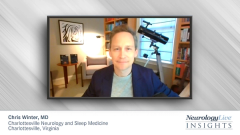
Pitolisant for Narcolepsy and EDS: FDA Approval and Personal Experience
Expert neurologist and sleep specialist Chris Winter, MD, discusses the FDA approval of pitolisant for patients with narcolepsy and excessive daytime sleepiness in the context of his own experience with this novel agent.
Episodes in this series

Transcript:
Chris Winter, MD:Pitolisant is very interesting because this drug was actually approved in Europe prior to its approval and use in the United States, not only as a drug for excessive sleepiness in narcolepsy but also as a drug for cataplexy. It’s been more recently approved in the United States. Initially, it was only approved for the use in excessive sleepiness in patients with narcolepsy, but more recently got a separate approval for the treatment of cataplexy, making it the second drug that’s FDA approved in the United States for cataplexy. This drug offers a couple of very unique features. The first being, it is the only drug that’s approved in the United States for the treatment of narcolepsy, either excessive sleepiness or cataplexy, that is not a controlled substance, which makes it different than the rest. The second reason it’s different is because it’s utilizing a chemical in our brain called histamine for its effects rather than dopamine or GABAB, as the other drugs do. Hence, it’s mechanism of action is very novel, and most people are under the impression that when you take an antihistamine, it makes you sleepy, so you can kind of think about this drug as being prohistamine or prowakening through that neurotransmitter. Again, when we’re thinking about the treatment of patients with this disorder, we like having options as physicians to hit those various neurotransmitters in our brain that are responsible for wakefulness.
The drug was FDA approved based upon the results of 2 trials. These were double-blinded, randomized placebo-controlled studies. They featured about 261 patients in the United States, and the end points were looking at both excessive daytime sleepiness as measured with that Epworth Sleepiness Scale score we mentioned before, but also a separate end point was the treatment of cataplexy. In these studies, both groups, the cataplexy and the excessive sleepiness, were statistically significant in terms of their positive results, meaning that these drugs outperformed placebo in both ways. In fact, when you look at the results of the HARMONY studies, you can actually see that not only was the full dose of pitolisant effective in excessive sleepiness and cataplexy, but the half dose was as well. Thus, this is a very useful tool that we as sleep providers have to treat patients who have narcolepsy, either by themselves, just taking pitolisant, or in combination with drugs the patients are already taking. Within some of those studies, safety and efficacy profiles showed that the use of pitolisant did not really affect other drugs we commonly use for narcolepsy, and the reverse was true as well. Thus, these drugs work very well together.
I find pitolisant to be helpful in all patients. We use this medication as initial therapy for some patients. As I said, we have 2 FDA-approved options right now for cataplexy. I love sodium oxybate. We use that very frequently in our clinical population, but it’s a little bit more of a cumbersome, difficult drug. It’s dosed at night. It’s a liquid, you have to wake up in the middle of the night to take it, versus pitolisant is a treatment for cataplexy that is 1 pill you take when you wake up in the morning. For some people, depending on schedules and other medical history, this drug might be a little bit more appropriate for them. Thus, in addition to being an initial therapy for some patients, it’s also a fantastic addition to therapy. It works well with other medications. The adverse effect profile is very small, and the drug is well tolerated. It works very well for a lot of patients, so we find that the efficacy of the drug is very reinforcing to our clinical practice. I should also mention that the drug is FDA approved for individuals who are 18 years or older. Hence, at this time, pitolisant is an option for patients 18 years and older; it does not have a pediatric indication at this point.
Transcript edited for clarity.
Newsletter
Keep your finger on the pulse of neurology—subscribe to NeurologyLive for expert interviews, new data, and breakthrough treatment updates.

































